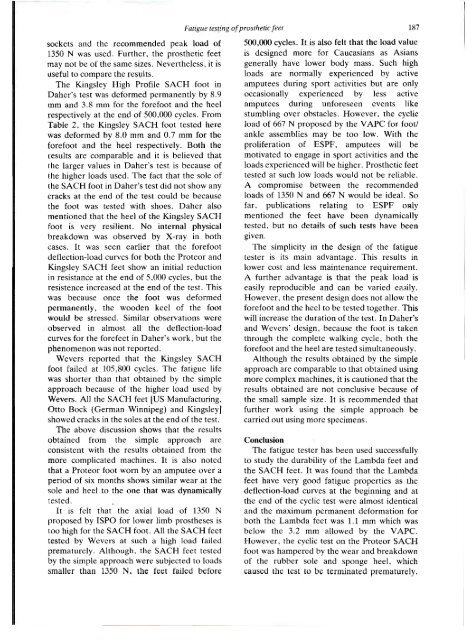Fatigue testing of energy storing prosthetic feet
Fatigue testing of energy storing prosthetic feet
Fatigue testing of energy storing prosthetic feet
You also want an ePaper? Increase the reach of your titles
YUMPU automatically turns print PDFs into web optimized ePapers that Google loves.
<strong>Fatigue</strong> <strong>testing</strong> <strong>of</strong> <strong>prosthetic</strong> <strong>feet</strong> 187<br />
sockets and the recommended peak load <strong>of</strong><br />
1350 N was used. Further, the <strong>prosthetic</strong> <strong>feet</strong><br />
may not be <strong>of</strong> the same sizes. Nevertheless, it is<br />
useful to compare the results.<br />
The Kingsley High Pr<strong>of</strong>ile SACH foot in<br />
Daher's test was deformed permanently by 8.9<br />
mm and 3.8 mm for the forefoot and the heel<br />
respectively at the end <strong>of</strong> 500,000 cycles. From<br />
Table 2, the Kingsley SACH foot tested here<br />
was deformed by 8.0 mm and 0.7 mm for the<br />
forefoot and the heel respectively. Both the<br />
results are comparable and it is believed that<br />
the larger values in Daher's test is because <strong>of</strong><br />
the higher loads used. The fact that the sole <strong>of</strong><br />
the SACH foot in Daher's test did not show any<br />
cracks at the end <strong>of</strong> the test could be because<br />
the foot was tested with shoes. Daher also<br />
mentioned that the heel <strong>of</strong> the Kingsley SACH<br />
foot is very resilient. No internal physical<br />
breakdown was observed by X-ray in both<br />
cases. It was seen earlier that the forefoot<br />
deflection-load curves for both the Proteor and<br />
Kingsley SACH <strong>feet</strong> show an initial reduction<br />
in resistance at the end <strong>of</strong> 5,000 cycles, but the<br />
resistence increased at the end <strong>of</strong> the test. This<br />
was because once the foot was deformed<br />
permanently, the wooden keel <strong>of</strong> the foot<br />
would be stressed. Similar observations were<br />
observed in almost all the deflection-load<br />
curves for the fore<strong>feet</strong> in Daher's work, but the<br />
phenomenon was not reported.<br />
Wevers reported that the Kingsley SACH<br />
foot failed at 105,800 cycles. The fatigue life<br />
was shorter than that obtained by the simple<br />
approach because <strong>of</strong> the higher load used by<br />
Wevers. All the SACH <strong>feet</strong> [US Manufacturing,<br />
Otto Bock (German Winnipeg) and Kingsley]<br />
showed cracks in the soles at the end <strong>of</strong> the test.<br />
The above discussion shows that the results<br />
obtained from the simple approach are<br />
consistent with the results obtained from the<br />
more complicated machines. It is also noted<br />
that a Proteor foot worn by an amputee over a<br />
period <strong>of</strong> six months shows similar wear at the<br />
sole and heel to the one that was dynamically<br />
tested.<br />
It is felt that the axial load <strong>of</strong> 1350 N<br />
proposed by ISPO for lower limb prostheses is<br />
too high for the SACH foot. All the SACH <strong>feet</strong><br />
tested by Wevers at such a high load failed<br />
prematurely. Although, the SACH <strong>feet</strong> tested<br />
by the simple approach were subjected to loads<br />
smaller than 1350 N, the <strong>feet</strong> failed before<br />
500,000 cycles. It is also felt that the load value<br />
is designed more for Caucasians as Asians<br />
generally have lower body mass. Such high<br />
loads are normally experienced by active<br />
amputees during sport activities but are only<br />
occasionally experienced by less active<br />
amputees during unforeseen events like<br />
stumbling over obstacles. However, the cyclic<br />
load <strong>of</strong> 667 N proposed by the VAPC for foot/<br />
ankle assemblies may be too low. With the<br />
proliferation <strong>of</strong> ESPF, amputees will be<br />
motivated to engage in sport activities and the<br />
loads experienced will be higher. Prosthetic <strong>feet</strong><br />
tested at such low loads would not be reliable.<br />
A compromise between the recommended<br />
loads <strong>of</strong> 1350 N and 667 N would be ideal. So<br />
far, publications relating to ESPF only<br />
mentioned the <strong>feet</strong> have been dynamically<br />
tested, but no details <strong>of</strong> such tests have been<br />
given.<br />
The simplicity in the design <strong>of</strong> the fatigue<br />
tester is its main advantage. This results in<br />
lower cost and less maintenance requirement.<br />
A further advantage is that the peak load is<br />
easily reproducible and can be varied easily.<br />
However, the present design does not allow the<br />
forefoot and the heel to be tested together. This<br />
will increase the duration <strong>of</strong> the test. In Daher's<br />
and Wevers' design, because the foot is taken<br />
through the complete walking cycle, both the<br />
forefoot and the heel are tested simultaneously.<br />
Although the results obtained by the simple<br />
approach are comparable to that obtained using<br />
more complex machines, it is cautioned that the<br />
results obtained are not conclusive because <strong>of</strong><br />
the small sample size. It is recommended that<br />
further work using the simple approach be<br />
carried out using more specimens.<br />
Conclusion<br />
The fatigue tester has been used successfully<br />
to study the durability <strong>of</strong> the Lambda <strong>feet</strong> and<br />
the SACH <strong>feet</strong>. It was found that the Lambda<br />
<strong>feet</strong> have very good fatigue properties as the<br />
deflection-load curves at the beginning and at<br />
the end <strong>of</strong> the cyclic test were almost identical<br />
and the maximum permanent deformation for<br />
both the Lambda <strong>feet</strong> was 1.1 mm which was<br />
below the 3.2 mm allowed by the VAPC.<br />
However, the cyclic test on the Proteor SACH<br />
foot was hampered by the wear and breakdown<br />
<strong>of</strong> the rubber sole and sponge heel, which<br />
caused the test to be terminated prematurely.
















